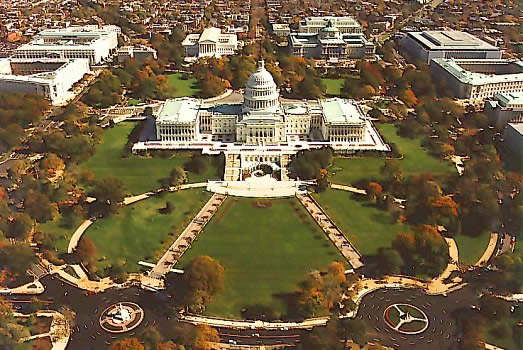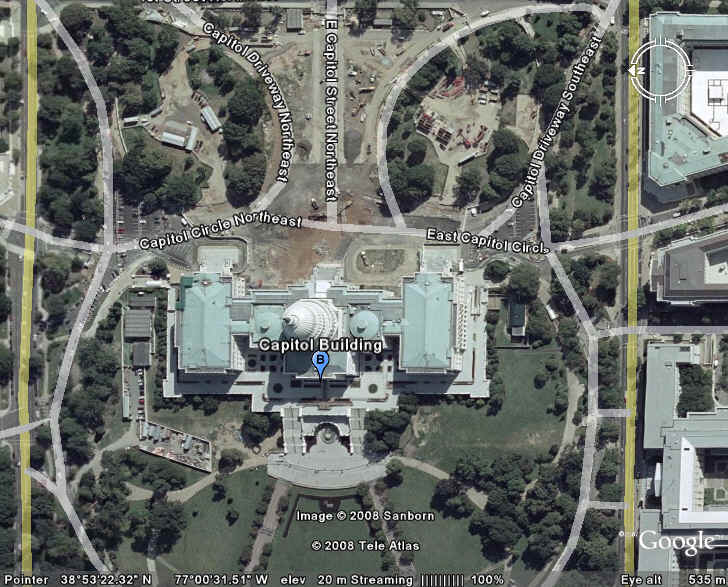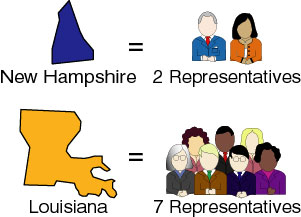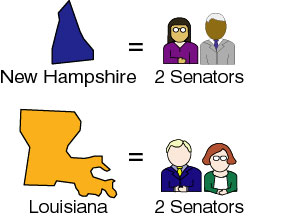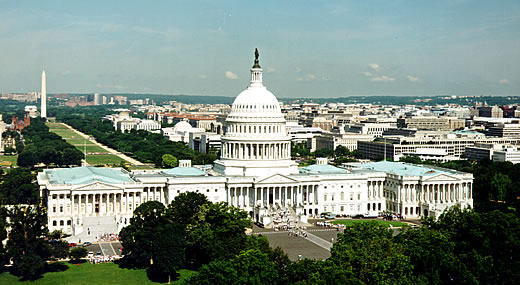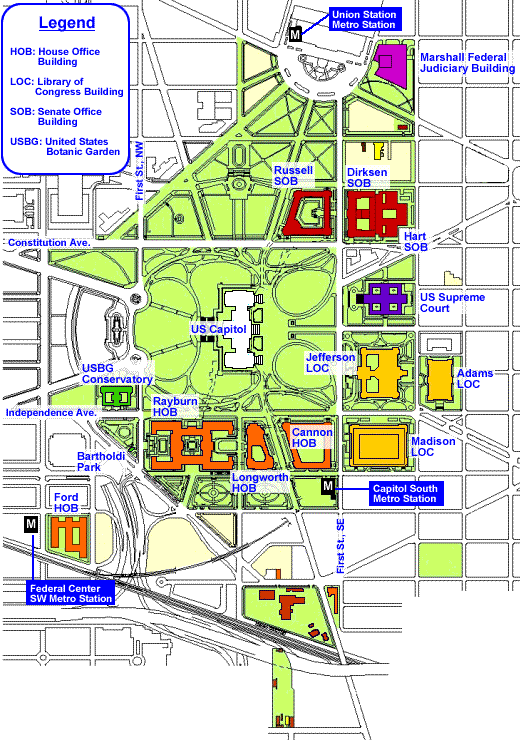
|
||||||||||||
|
|
|
The United States Congress
The United States Congress is part of the legislative branch and is made up of two houses -- the House of Representatives and the Senate. This two house system is known as a bicameral legislature. The primary duty of Congress is to write, debate, and pass bills, which are then passed on to the president for approval. Other congressional duties include investigating pressing national issues and supervising the executive and judicial branches.
Every two years, voters get to choose all 435 representatives and a third of the senators. The entire House membership faces re-election every two years, but the Senate is a continuing body because there is never an entirely new Senate. A new Congress begins in January following Congressional elections. Since the First Congress, which met from 1789 to 1791, all Congresses have been numbered in order. Congress meets once every year and usually lasts from January 3rd to July 31st, but in special cases, a session can last longer.
For the most part, the House and Senate each meet in their respective chamber in the U.S. Capitol in Washington, D.C.; however, on rare occasions, they will convene for a joint session of Congress in the House chamber. For example, a joint session will be called to count electoral votes for presidential elections. The House of Representatives When the Constitution was being drafted, a debate broke out between states with large populations and those with smaller populations. Each had a different opinion about how the states should be represented in the new government. To be fair to each group, a compromise was reached. By dividing Congress into two houses, the House of Representatives would favor states with larger populations, while the Senate would favor those states with smaller populations.
There are a total of 435 members in the House of Representatives. Each member represents an area of a state, known as a congressional district. The number of representatives is based on the number of districts in a state. Each state is guaranteed one seat. Every ten years, the U.S. Census Bureau counts the population of the states to determine the number of districts in each state. Representatives, elected for two-year terms, must be 25 years old, a citizen for at least seven years, and a resident of the state from which they are elected. Five additional members—from Puerto Rico, Guam, American Samoa, the Virgin Islands, and the District of Columbia—represent their constituencies in the House. While they may participate in the debates, they cannot vote. The House has special jobs that only it can perform. It can: Start laws that make people pay taxes. Decide if a government official should be put on trial before the Senate if s/he commits a crime against the country. The Senate
There are a total of 100 members in the Senate. The Constitution states that the vice president has formal control over the Senate and is known as the president of the Senate. In actuality, the vice president is only present for important ceremonies and to cast a tie-breaking vote. Senators, elected for six-year terms, must be 30 years old, a citizen for at least nine years, and a resident of the state from which they are elected. As in the House, the Senate also has special jobs that only it can perform. It can: Confirm or disapprove any treaties the President drafts. Confirm or disapprove the Presidential appointments, such as the Cabinet, officers, Supreme Court justices, and ambassadors. Holds a trial for a Government official who commits a crime against the country. First Meetings
Firsts Among Members:
First Events
The Powers of Congress The Constitution grants Congress "all legislative powers" in the national government. Article I, Section 8, of the Constitution lists a wide range of congressional powers, including: Coining money. Maintaining a military. Declaring war on other countries. Regulating interstate and foreign commerce Congress also controls federal taxing and spending policies—one of the most important sources of power in the government. The Constitution also gives Congress the authority to "make all laws which shall be necessary and proper," an implied source of power sometimes called the Elastic Clause. One of the most important implied powers is Congress’s authority to investigate and oversee the executive branch and its agencies, such as the Department of Defense and the Department of Justice. As part of this responsibility, which is known as oversight, Congress summons senior officials to answer questions from members, orders audits of agencies, and holds hearings to air grievances of citizens. Congress also holds hearings on matters of general public concern. Sometimes members of Congress conduct these hearings to identify problems that create a need for new laws. In other cases Congress holds hearings to raise public awareness about an issue. There are, however, some congressional powers that are rarely used such as the ability to impeach an official and the ability to amend the Constitution. In addition to the power described above, Congress shares powers with the president in matters such as, framing U.S. foreign policy and control over the military. For example, while the president negotiates treaties, they are only put into effect once the Senate approves them. Also, while Congress can declare war and approve funds for the military, the president is the commander-in-chief of the military. The United States Capitol: An Overview of the Building and Its Function
The United States Capitol in Washington, D.C., is among the most architecturally impressive and symbolically important buildings in the world. It has housed the meeting chambers of the Senate and the House of Representatives for almost two centuries. Begun in 1793, the Capitol has been built, burnt, rebuilt, extended, and restored; today, it stands as a monument not only to its builders but also to the American people and their government. As the focal point of the government's Legislative Branch, the Capitol is the centerpiece of the Capitol Complex, which includes the six principal Congressional office buildings and three Library of Congress buildings constructed on Capitol Hill in the 19th and 20th centuries. In addition to its active use by Congress, the Capitol is a museum of American art and history. Each year, it is visited by an estimated 3-5 million people from around the world. A fine example of 19th-century neoclassical architecture, the Capitol combines function with aesthetics. Its designs derived from ancient Greece and Rome evoke the ideals that guided the nation's founders as they framed their new republic. As the building was expanded from its original design, harmony with the existing portions was carefully maintained. Today, the Capitol covers a ground area of 175,170 square feet, or about 4 acres, and has a floor area of approximately 16-1/2 acres. Its length, from north to south, is 751 feet 4 inches; its greatest width, including approaches, is 350 feet. Its height above the base line on the east front to the top of the Statue of Freedom is 288 feet; from the basement floor to the top of the dome is an ascent of 365 steps. The building contains approximately 540 rooms and has 658 windows (108 in the dome alone) and approximately 850 doorways. The building is divided into five levels. The first, or ground, floor is occupied chiefly by committee rooms and the spaces allocated to various congressional officers. The areas accessible to visitors on this level include the Hall of Columns, the Brumidi Corridors, the restored Old Supreme Court Chamber, and the Crypt beneath the Rotunda, where historical exhibits are presented. The second floor holds the Chambers of the House of Representatives (in the south wing) and the Senate (in the north wing) as well as the offices of the congressional leadership. This floor also contains three major public areas. In the center under the dome is the Rotunda, a circular ceremonial space that also serves as a gallery of paintings and sculpture depicting significant people and events in the nation's history. The Rotunda is 96 feet in diameter and rises 180 feet 3 inches to the canopy. The semicircular chamber south of the Rotunda served as the Hall of the House until 1857; now designated National Statuary Hall, it houses part of the Capitol's collection of statues donated by the states in commemoration of notable citizens. The Old Senate Chamber northeast of the Rotunda, which was used by the Senate until 1859, has been returned to its mid-19th-century appearance. The third floor allows access to the galleries from which visitors to the Capitol may watch the proceedings of the House and the Senate when Congress is in session. The rest of this floor is occupied by offices, committee rooms, and press galleries. The fourth floor and the basement/terrace level of the Capitol are occupied by offices, machinery rooms, workshops, and other support areas.
|
